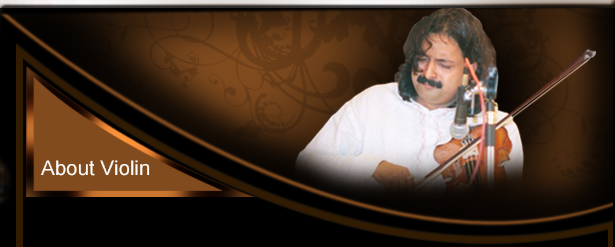The zenesis of Violin has a topsy-turvy family tree. Each of its parts has its own history. The present day Violin was developed & standardized in Italy during the 16th century.
The origin of stringed instruments played by rubbing the strings is linked to the appearance of the bow. The more ancient stringed instruments were played by plucking the strings with the fingers. Perhaps the bow was at first a simple stick before the hair-bow was adopted. As there is no trace of a bow instrument in classical antiquity, it is freely admitted that the bow was imported from Asia by the Arabs or the Nordic tribes. But whether the evolution occurred in northern Europe, the Near East, India or Central Asia remains a mystery... The bow may have appeared in various places at the same time, as did several major discoveries in the history of mankind!
In India, the origin of Violin is traced into the Ravanastrom.This instrument is said to have belonged to a sovereign of India 5000 BC. Again, it also replicates the ancient instrument called Ravan Hatta which is found even today in Rajasthan. Mythology credits this creation to the demon king Ravana from Ramayana. The Ravan Hatta was played on one string which was 22 inches long encompassing the 3 Octaves. Whereas the Violin encompasses the 3 octaves on 4 strings with a finger board which is 5 1/4th inches long. This 5 1/4th when multiplied by 4 is 22 inches which was the size of the Ravan Hatta. Both are played with a bow.
However, scholars believe that the present day Violin predecessor existed in India from 400 BC. From here it travelled to Persia and Middle East Asia through the Arabs during the 6th – 7th centuries where it emerged as the Rababeh . Rababeh then went into Spain through the Arabs during the invasion of Moors during the 10th – 11th centuries and became the LIRA DA BRACCIO. From Spain it spread in whole of Europe.
In Europe, the violin can be traced back to the 9th century, with its origin possibly in Asia. Not less than 450 years were required to bring it to its present form, representative of the experience acquired throughout the centuries by the makers of stringed instruments. The number of strings soon grew from one or two to three or four. As early as the beginning of the 11th century the classical form of the five-stringed VIELLE came into being and remained until the 16th century. Little by little ribs were introduced to facilitate the use of the bow; the plaque to which the strings were fitted, characteristic of the plucked stringed instruments, was replaced by a separate tailpiece and bridge, more appropriate for bowed instruments. Thus gradually the transition was made from the stringed instrument of the middle Ages to the RENAISSANCE VIOL equipped at first with a round opening that was eventually transformed into two crescent-shaped sound holes. The VIOLA DA BRACCIO resulted from reducing the number of strings of the VIELLE to three or four, adopting the peg box and the lateral pegs of the REBEC as well as the tuning in fifths, which is most convenient for small arm instruments as it allows the use of four fingers, thus increasing both the range and the maneuverability. It should be noted that the ribs are much lower than in the VIOLA DA GAMBA, and the cut-out becomes increasingly marked. As for the two sound holes, which at the beginning were C or crescent-shaped, they soon adopted the form of a ƒ as in the modern violin.
Following a series of combinations of the two primitive types, three other families of instruments appeared before 1500: the VIOLA DA GAMBA(viol held on or between the player’s knees), the LIRA DA BRACCIO (played with a bow) and the VIOLA DA BRACCIO (held against the shoulder). It is from the VIOLA DA BRACCIO that the VIOLIN evolved. After travelling around the world Violin came back into India in its present form as early as the 17th century and Baluswami Dikshitar (brother of a famous composer in Carnatic music Muttuswami Dikshitar) was the first Indian musician to adapt the western Violin and popularize its use in Carnatic music. It is a relatively new entrant in Hindustani music having probably been here for the past 100 years.
Tuning
Tuning denotes a number of musical notes they produce a pleasent pattern and arrangement of musical sound .
In Western Classical music the tuning is predominantly standardised to the notes G D A E. It is tuned at intervals of a fifth to set it in vibration, thereby making it capable of greater flexibility in range, tone and dynamics.
In the Middle East Classical system, Morrocans use the normal G D A E tuning, while the Turks use the G D A D tuning. The Arabs use G D G D and the Italians use all three.
In the Indian Classical system the four strings are tuned as follows: Dominant Pa, Tonic Sa, Dominant Pa octave lower and Tonic Sa octave lower from the 1st to the 4th string respectively with the tonic being variable in pitch.It could be the other way too Sa Pa Sa Pa from the 1st to the 4th string again with the tonic being variable in pitch. |


